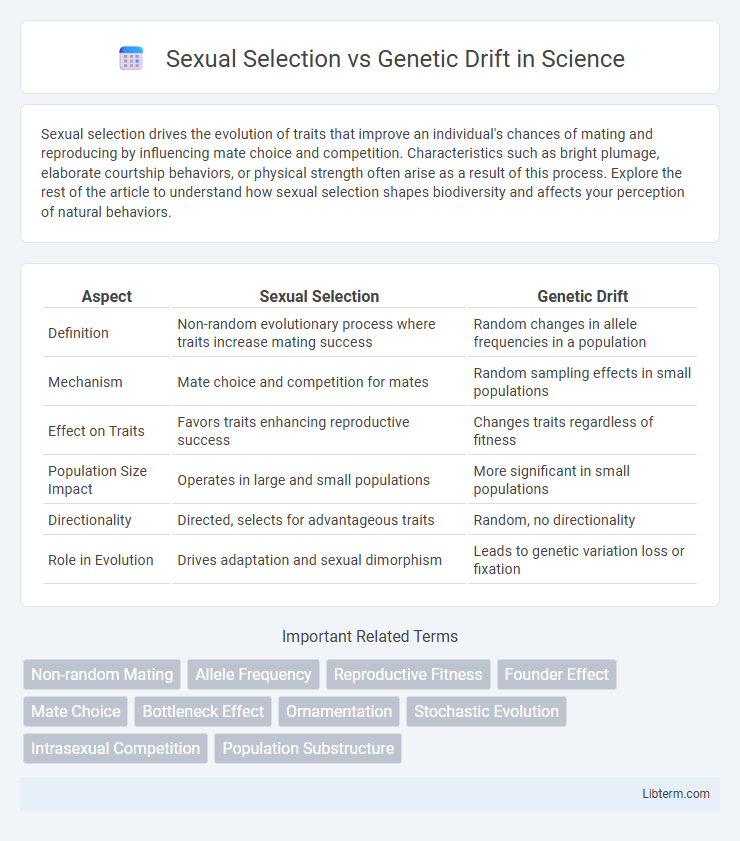Sexual selection drives the evolution of traits that improve an individual's chances of mating and reproducing by influencing mate choice and competition. Characteristics such as bright plumage, elaborate courtship behaviors, or physical strength often arise as a result of this process. Explore the rest of the article to understand how sexual selection shapes biodiversity and affects your perception of natural behaviors.
Table of Comparison
| Aspect | Sexual Selection | Genetic Drift |
|---|---|---|
| Definition | Non-random evolutionary process where traits increase mating success | Random changes in allele frequencies in a population |
| Mechanism | Mate choice and competition for mates | Random sampling effects in small populations |
| Effect on Traits | Favors traits enhancing reproductive success | Changes traits regardless of fitness |
| Population Size Impact | Operates in large and small populations | More significant in small populations |
| Directionality | Directed, selects for advantageous traits | Random, no directionality |
| Role in Evolution | Drives adaptation and sexual dimorphism | Leads to genetic variation loss or fixation |
Introduction to Sexual Selection and Genetic Drift
Sexual selection is a mode of natural selection where certain traits increase an individual's chances of mating and passing on genes, driving the evolution of characteristics linked to reproductive success. Genetic drift refers to random changes in allele frequencies within a population, especially in small populations, leading to genetic variation independent of selective pressures. Both mechanisms contribute to the evolutionary process but differ in their influence on genetic diversity and adaptation.
Defining Sexual Selection: Mechanisms and Examples
Sexual selection is an evolutionary mechanism where certain traits increase an individual's chances of mating and passing on genes, driven by mate choice or competition among individuals. Mechanisms include intersexual selection, where one sex selects mates based on specific characteristics such as peacock tail feathers, and intrasexual selection, involving direct competition like deer antler clashes. Examples of sexual selection demonstrate traits like bright coloration in birds of paradise or elaborate courtship dances in manakin species, which enhance reproductive success rather than survival.
Understanding Genetic Drift: Causes and Effects
Genetic drift refers to random fluctuations in allele frequencies within a population, primarily caused by chance events rather than natural selection. This process is most pronounced in small populations, where it can lead to the loss of genetic variation and increased genetic differentiation between populations. Over time, genetic drift can reduce genetic diversity, potentially impacting a population's adaptability and survival.
Key Differences Between Sexual Selection and Genetic Drift
Sexual selection is a non-random evolutionary process driven by differential mating success based on traits that enhance reproductive advantage, whereas genetic drift is a random fluctuation in allele frequencies due to chance events, especially in small populations. Sexual selection often results in exaggerated physical or behavioral traits, such as peacock feathers or elaborate mating calls, while genetic drift can lead to the fixation or loss of alleles independent of their adaptive value. Unlike genetic drift, sexual selection directly influences reproductive fitness and operates through mate choice or competition, shaping population genetics in a directional manner.
Genetic Variation: Impact of Sexual Selection vs Genetic Drift
Sexual selection significantly increases genetic variation by favoring traits that enhance mating success, leading to greater allele diversity within populations. In contrast, genetic drift causes random fluctuations in allele frequencies, often reducing genetic variation, especially in small populations. While sexual selection drives adaptive changes through mate choice, genetic drift promotes genetic divergence and can result in the loss of rare alleles over time.
Role in Evolution: Adaptive vs Non-Adaptive Processes
Sexual selection drives adaptive evolution by favoring traits that increase reproductive success, often leading to pronounced physical or behavioral characteristics. Genetic drift, in contrast, is a non-adaptive process causing random changes in allele frequencies, especially in small populations, which can result in the fixation or loss of traits regardless of their survival advantage. Both mechanisms contribute to evolutionary change, but sexual selection typically promotes advantageous adaptations while genetic drift introduces variability without direct selection pressure.
Case Studies: Real-World Examples in Nature
Sexual selection drives traits like the extravagant plumage in peacocks, enhancing mating success and showcasing adaptive evolution through mate preference. Genetic drift, observed in isolated populations such as the Florida panther, causes random allele frequency changes resulting in reduced genetic diversity and unique phenotypic traits. Studies on cichlid fish in African lakes reveal sexual selection's role in speciation, while genetic drift in island bird populations demonstrates stochastic effects on gene pools independent of reproductive advantage.
Interplay Between Sexual Selection and Genetic Drift
Sexual selection and genetic drift interact by influencing allele frequencies in populations through distinct mechanisms, where sexual selection drives traits that improve mating success, and genetic drift causes random changes independent of fitness. In small populations, genetic drift can overpower sexual selection, leading to fixation or loss of sexually selected traits despite their reproductive advantage. The interplay between these forces shapes evolutionary trajectories, impacting phenotypic diversity and speciation rates.
Implications for Species Diversity and Evolution
Sexual selection drives species diversity by favoring traits that increase mating success, often leading to pronounced sexual dimorphism and rapid evolutionary changes. Genetic drift causes random fluctuations in allele frequencies, impacting smaller populations and potentially reducing genetic variation over time. Together, these mechanisms shape evolutionary trajectories by balancing adaptive trait development and stochastic genetic shifts within species.
Conclusion: Integrating Sexual Selection and Genetic Drift in Evolutionary Theory
Integrating sexual selection and genetic drift in evolutionary theory provides a comprehensive understanding of genetic variation and phenotypic diversity within populations. Sexual selection drives the evolution of traits that enhance mating success, while genetic drift causes random fluctuations in allele frequencies, especially in small populations. Recognizing the interplay between these mechanisms elucidates complex evolutionary dynamics and helps explain patterns of adaptation and speciation.
Sexual Selection Infographic

 libterm.com
libterm.com